The following information on handgun quick draws comes from Section 29 of Shooting by J. Henry FitzGerald. Shooting is also available to purchase in print.
Quick draw is a very fascinating sport and one in which many are interested. I rarely speak before a club or police department where I am not asked to show the quick draw. Let me caution the beginners: BE SURE that your revolver is empty before trying quick draw or any new tricks with a revolver. Do not load it until you have first mastered the stunt you wish to try with the revolver or pistol empty.
Quick-draw shooting is practical police shooting, the recognized system of protection used by proficient peace officers throughout the land, and it means just this: when occasion requires it, get your revolver quick and shoot quick and straight when you do get it. Know the position of your revolver and get it without taking your eyes from the object you are to shoot at. Shoot double action if it is at short range and quick draw is not necessary at long range.
The double-action revolvers are referred to because they are universally carried, due to the weight of the arm and time which must elapse before the beginner would familiarize himself with the manipulation of the old Peace Maker. Whether the revolver is carried on the outside or under the coat a little practice in getting it out will gain valuable time.
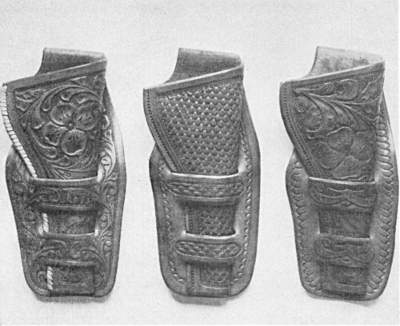
The first article to purchase is a revolver suited for your particular need, and a belt and holster should be purchased after the arm is decided upon. A New Service or arm of corresponding weight would call for a two, two and one-half, or three inch belt if revolver is to be comfortably carried. If a lighter arm of thirty-two to thirty-five ounces is carried then a belt of one and one-half to two inches may be worn. If the 22-ounce revolver is worn, then the one and one-half inch belt is sufficient. I may here describe my own belt, which is heavy because I carry two New Service revolvers on it. It was made for me by Captain A. H. Hardy, Beverly Hills, California. It is three inches wide and at the top on the inside is stitched a thin piece of tough, serviceable leather in which are cut buttonholes to match the trousers buttons. The bottom of each hole is finished with a punch to prevent tearing. If revolvers are to be carried in the trousers pockets more buttons and buttonholes may be added to support the extra weight. If the revolvers are carried in holsters this is not necessary. No belt loops or hooks are necessary, as the belt never changes position after once being attached. Another advantage of this belt is that a holster never changes position due to the buttons.
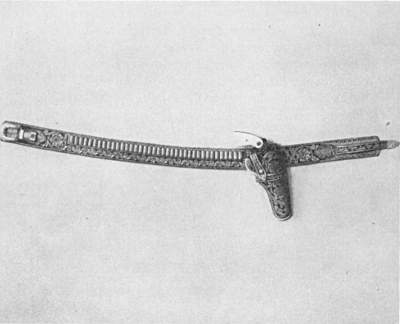
Now for a heavy, serviceable holster, for it is money thrown away to buy the light, flexible holsters which flood the market. I have encountered thousands of men carrying such holsters and they are what I term “suicide holsters,” for the reason that they will buckle or snag nearly every time the arm is drawn. Another holster which is dangerous is the one that is too short for the revolver, with the barrel sometimes extending through the bottom from one to two inches. Open-end holsters are recommended because all dirt and lint will fall through, but they are not recommended when they are too short to cover the barrel and sight. Of course only open holsters are spoken of for quick-draw work because it is hard to associate safety straps, springs, and closed or flap holsters with quick draw.
Before the holster is procured the user must determine what kind of a draw he wishes to become accustomed to,—the cross-stomach draw, suspender draw, the side draw, the leg draw, the shoulder draw, the pocket draw, the hip pocket draw, or the sleeve draw.
The cross-stomach draw is an old favorite of mine and very fast if it is perfected. Some years ago in the West a sheriff, an old friend of mine, told me in no uncertain terms what he thought of the cross draw and asked me to draw and see what happened. His idea was to grasp the wrist of the gun hand and block the draw. The only reason that it wasn’t a complete success was that I did not draw the way he thought I would. As I drew I placed the other hand and arm outside the one I drew the revolver with and as he caught the wrong wrist the muzzle was against his stomach.
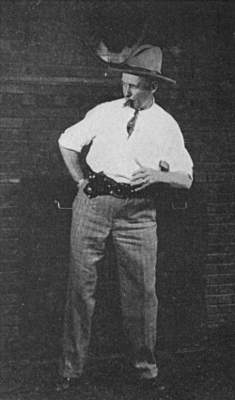
The cross draw requires a holster that would not be right for any of the others. It should hang on the belt, butt pointing slightly outward one inch above the top of the belt and at an angle of thirty degrees, the butt tipping toward the hand with which the arm is to be drawn, then it does not have to be lifted out of the holster, but is drawn with a circular motion, with barrel nearly parallel as the revolver leaves the holster. Due to angle and crouch the holster in all cases should be fitted to the revolver with which it is to be used. This holster may be fitted after loop is fashioned to hold revolver at thirty-degree angle, by cutting away holster to allow the finger to fall on trigger as arm is grasped. By cutting away leather on belt loop and holster back, the hand will fall naturally on grip so that position of hand will not have to be changed after draw. (See two-inch holster in this section.)
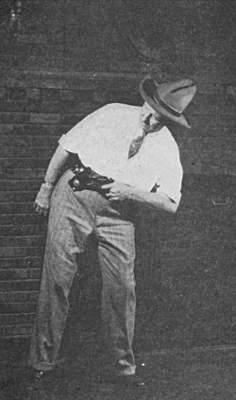
Moisten the holster with water until it is thoroughly pliable, cover revolver with gun grease, including inside of barrel and cylinder; place the arm in holster and with fingers press leather around revolver until holster is shaped to the arm. Be sure leather is wet enough to retain this shape, but do not soak it in water. I use a paint brush and moisten it from the outside. When thoroughly fitted place in the sun and air for about six hours until the leather is partly dry, then remove the revolver and clean it thoroughly. Allow the holster to set for several days until thoroughly dry, then oil with a small brush and pure Neet’s foot oil and you then have a holster that you can pass along to the next generation. A revolver will not drop out of a holster so prepared.
I am not stating that the cross draw is the fastest draw in the world, but we who live in cities cannot wear two revolvers low down on the legs and tied down; so about all that is left for us in civilian clothes is the cross draw, shoulder holsters, and pocket draw. The two, four, or six inch barrel may be used. I would recommend .38 or larger. The two-inch Detective Special is the fastest, due to the short barrel; the four-inch of the same model is very light (22 ounces) and universally carried. The Official Police, in four, five, and six inch barrels, is heavy and serviceable. Requirements and personal choice, also size of hand, will determine what arm to purchase.
Why I specified that the holster must be cut away in a manner that would allow a perfect grip of the revolver while it was still in the holster is that the hand, thumb, and fingers will take the position before the draw is started. This will enable each of them to fall in place on the revolver handle, saving time in drawing and also eliminating any change in hold after arm is drawn.
When preparing to start practice in quick draw cut the finger and thumb nails close or broken nails will be the result. Do not try for speed until thoroughly familiar with the position of the revolver and the position the hand must assume for a smooth, easy draw. Learn where the revolver is and be able to place your hand on it correctly without taking your eyes away from the object you want to hit. When you have acquired this first step you are ready to practice the draw.
It is best to learn each operation separately, that is, draw, aim, and snap. I have noted many persons practice the draw who could not seem to avoid tipping the revolver when it was drawn. Practice drawing until the revolver comes out straight up, sights level. In this work the muscles are held more rigid than in target shooting. Practice this first third of the draw until the revolver seems to jump into your hand smoothly and easily. If you speed up before you have learned the position of the trigger and guard you will have a battered nail and tip on your trigger finger.
We have progressed to the pointing stage and here the trick is to allow the barrel of the revolver to replace the finger in pointing. Nearly every one can point his finger accurately enough to be inside a six-inch circle at twelve feet and with a little practice the revolver barrel will take the place of the finger if it is correctly grasped in the hand. Up to six feet, or, in the case of the expert, eight feet, the arm need not be brought above waist level; as the distance increases beyond this point time and accuracy are gained by pushing the revolver outward and upward, pulling trigger at the same time, the hammer falling as arm and revolver reach the end of the thrust.
We have now reached the third stage or snapping. I stated before that it was best to take up each stage separately, or after perfecting the draw learn to point; after being able to draw and point, learn to squeeze the trigger, and then combine all three. Stand in front of a large mirror and learn what you are doing. Revolver empty or seven years bad luck, and the price of a mirror will be the result. In final practice do not make the mistake of drawing, pointing, and then putting the revolver back in the holster. Draw, point, and snap; go through the entire motion. The last stage, snapping, or trigger squeeze, is very important. I have heard many argue that a double-action revolver could be fired as quickly single action as double in this quick-draw work, but I have never found any one who could do it and I do not believe it can be done, so we will speak of double action up to fifteen feet.
In cross draw BE VERY CAREFUL TO KEEP ARM AND HAND NOT USED OUT OF LINE OF FIRE; rest arm against side of body and tense muscles to hold revolver against side sway, pulling trigger straight back. In this work I do not recommend holding thumb along top of frame above latch as in target shooting; lay it alongside of frame below latch and slightly bent or in position thumb will take when revolver is drawn, not forgetting to use thumb pressure to eliminate putting revolver to left. In rear of this section are pictures to further explain the cross-stomach draw.
The position of the crouch, of course, is changed with different individuals, but in my own case I have found this position very fast, between twenty-five and fifty one-hundredths of a second. In the crouch revolver is pointed with the body movement at the hips; this speeds up the draw as you are aiming with the body or assuming a position that will tilt the thirty degree holster to a level position, bottom on a line with top. The shot is fired just after the revolver leaves the holster on the line it is drawn.
The holster for cross draw may also be used when drawing a short barrel revolver, to fire a shot with the revolver upside down, using the other hand. In this draw the revolver is grasped in a manner that will bring the third finger on trigger and little finger along bottom of frame as a guide, the thumb and two first fingers grasping butt. As the bottom of butt is usually parallel with barrel at short range up to six feet aim or point with bottom of butt six inches above point you wish to hit with a bullet. This is only used for an emergency shot where opposite hand is engaged or out of commission.
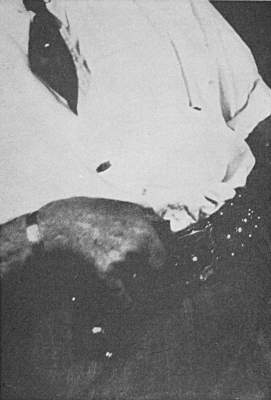
With practice a revolver may be drawn and fired faster than the ordinary man can draw and fire with revolver in normal position. Use the Langrish or Colt Silhouette targets for quick-draw practice. The upside-down draw is faster than drawing by twisting the wrist to grasp butt which is in reversed position.
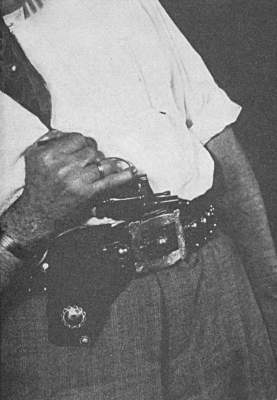
In the rear of this section may be seen my old friend, Dr. H. R. Brunton, wearing the best suspender holsters I have ever seen. They are very useful in carrying revolvers to and from the range and to see the doctor get a gun out of one of these holsters will convince the onlooker that the suspender holster is very practical. Even when they are not used to carry revolvers they are not uncomfortable. The holsters are attached at three points and in this holster light, tough leather may be used, taking care to have holsters extend below barrel. This draw is faster than the shoulder draw, due to lower position of revolver and tied-down holsters.
The leg or thigh draw, hand height: Revolvers worn in this position usually on cross belts at a height that will allow the half-closed hand to just sweep the butts and bottom of holsters tied down with rawhide thong around leg (this is better than a buckle and strap attached to chaps or trousers). Attach the holsters in a manner that will swing the butts slightly outward and muzzle slightly to the rear about ten degrees. The position of the draw is standing on balls of the feet which are twelve to fifteen inches apart; a slight bending of the knees and throwing stomach slightly forward add to the speed of this draw. As the guns are thrown forward the body is bent backward to aid in bringing revolvers to a level position. The hands are closed to a position that will enable the fingers and thumb to close quickly around butts as they strike. This is a very fast draw and preferred by the western gunmen of the old school and many are still being worn in the wide open spaces.
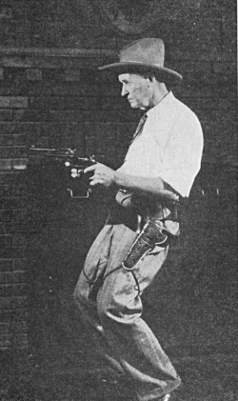
The side draw from belt is very good and much used, but it is slow if revolver is worn high on belt because the elbow must be bent at such a sharp angle to grasp the butt and at a sharper angle to draw the revolver, especially if five or six inch barrel is used. The holster on the belt cannot hang far below the belt unless it is tied down because it is liable to buckle. A holster with a stiff heavy back to prevent this is disagreeable to wear and by use will become flexible. I have noted thousands of revolvers carried in this position and ninety per cent of them so carried are slow in coming out, due to being carried too far back, ill-fitting holsters or wrong angle of holster on belt. Many police officers and others whose duty it is to protect, believe that all that is needed is to carry a revolver. It is not. Carry it where you can get it. The fastest angle of holster on belt for drawing from this position is—bottom of holster one inch to rear of center of holster top and worn just ahead of the hip joint. The speed is aided by throwing the shoulder upward and forward as the arm is drawn. Holsters should be cut away as before described and properly fitted. If the holster is worn too far back it can only be reached by one hand.
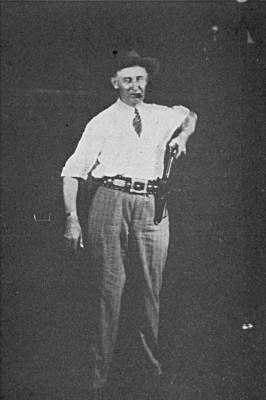
The shoulder holster used in the shoulder draw is a favorite with many, but it has its faults. First, it is disagreeable to wear unless the wearer is used to the old-fashioned suspenders. Secondly, it is too far for the hand to travel when the hands are hanging at side in a natural position. Two kinds of shoulder holsters are on the market,—the open-top, old-style holster and the spring holster or new model. The first, or open-top holster, is very awkward and hard to draw from because the revolver must be drawn upward, sometimes striking the arm or catching in shirt or coat lining and it may buckle if not tied down to belt. The latter, or spring-shoulder holster, is ideal if this position is satisfactory, and very fast because the revolver is not drawn but ripped out of the holster without being drawn, saving valuable time. The position of the body when drawing: side on which the revolver hangs should be toward object to be hit and shoulders thrown in direction away from target as arm is drawn and shot fired from breast height if at short range. Much may be said in favor of the shoulder holster, when riding in an automobile, train, or other conveyance, or in a sitting position, or under coats that are worn buttoned but are open at the top. It is not as good to wear on a hunting trip as a belt holster, due to rifle or shot gun striking it if worn on shoulder from which rifle or shot gun is fired.
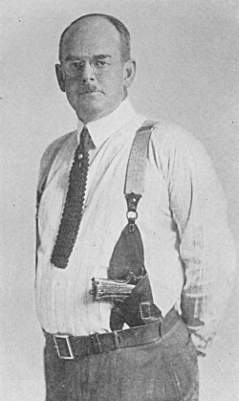
The front pocket draw, while not universally used, is very good. The front pocket is a good place to carry a revolver, especially one of those mentioned in the section “Special Arms for Quick Draw.” The pocket is lengthened so that butt of revolver will be one inch below pocket opening and opening should be one inch longer than regular. The extension in bottom front corner of the pocket should be V-shape and wide enough to hold revolver loosely. This extension may be made of canton flannel, soft side in and seam on inside for muzzle to rest upon. The side of the pocket may be fastened to the outside trousers seam to avoid snagging. Use the thumb over hammer when drawing regular model. We feel many times that a revolver would be a good companion on an automobile or camping trip, but in hot weather it is not easy to conceal especially if the coat is not worn all the time, but it may be carried in the front pocket as described above. It is comfortable to wear and after a few days will not worry the wearer. While this draw from hands at side is not as fast as some of the others it can be improved with practice and at first appearance or feeling of danger the hand may be slipped into the pocket and owner may still look peaceful and innocent. In this position he need not fear any kind of a draw as he has his revolver in his hand. In this draw the hand and arm must do the work. The position of leg draw would assist but this is a surprise shot from an innocent position and the leg-draw position advertises the intentions too plainly to be misunderstood.
The hip pocket draw, while not as slow to the man who has practiced it, is condemned for many reasons. The hip pocket draw was at one time universally used and every one knows about that pocket as the logical place to carry a revolver. Any one can approach from the rear and get possession of the revolver before the owner could stop him. It is a place where, if the gun hand is held, the revolver cannot easily be reached with the other hand. Every revolver carried for protection should be carried to hang in a line or in front of arms hanging at the side. To slightly speed this hip pocket draw use leg draw position. Holsters are made that fit hip pocket and hold revolver upright, many of them with safety straps. If any of my readers should use such an outfit the only place they will find sympathy is in the dictionary.
The sleeve draw is performed with a small revolver and an elastic band, such as a piece of an inner tube, about three inches long. The revolver is worn butt down in position to be grasped by the other hand. It is disagreeable to wear for any length of time and hands must be brought together before the draw.
The swivel draw is performed by using a specially constructed swivel, part of which is attached to the belt and part to side of revolver, allowing butt to be grasped and muzzle brought in to line without detaching from belt, or it may be detached for a long shot. I see no advantage in this combination as it is not as fast as cross or leg draw and body must be turned, as angle of fire from one position is limited and distance must be short.
Another combination on the same order is the holster attached to belt by swivel of the same kind and holster cut away in a manner that will allow revolver to be fired while in the holster or may be drawn if desired. The holster, of course, has an open end. The same disadvantage is noticeable in this as in the gun and belt swivel,—the handle is not stationary and may swing as the arm is grasped.
Another surprise draw is the waist-band draw. In the absence of a holster the arm may be carried in the waist band or, in other words, next to the shirt inside the belt and trousers. This is very effective and I have never dropped a revolver carried in this position. It is usually carried as in cross draw as to position, and while not as fast as holster draw it is dangerous for the other man. Of course the arm will be more liable to rust from body perspiration.
Several years ago while traveling in the South I gave a demonstration to a certain police department. In the course of the quick-draw work I caught my shirt as the revolver was drawn, nearly spoiling the draw. A gentleman who was present came to me after the exhibition and asked me to go across the street with him to a clothing store. There he showed me a garter that, if attached to bottom of shirt and stocking, always kept the shirt down in place. I have used it ever since and have never since caught the shirt in quick-draw work.
Several surprise draws are used, as the leg and stocking draw. A small, thin holster is strapped around the leg on inside above the ankle, lower end in stocking, and a small revolver is used. The surprise may be aided by a long shoestring that may be untied by stepping on end with other foot, then, in stooping down to tie it, get the revolver and surprise is complete. The hat is another place to carry a small revolver or automatic pistol for the intentions would not be suspected. The back of the neck between the shoulders is another hideout for small firearms or knife and a place which should be searched if looking for weapons. A large necktie or open shirt may sometimes conceal a weapon as a shoulder holster may be worn under a shirt. The glove or mitten draw is sometimes used if trouble is anticipated at a given time and consists of a glove large enough to cover a small revolver and the hand. To get into action pull off the glove.
The overcoat cuff is sometimes utilized in carrying a small revolver. If cuff is large enough the revolver is carried muzzle toward hand and butt up on inside of wrist.
The outside pocket draw, if hand is in pocket, is very fast and dangerous for the hold-up gent, as a command of “Hands Up” means hand and gun up at the same time. The overcoat pocket is better adapted to this than the inside coat pocket due to size and weight of cloth. Shooting through the pocket may be accomplished if thumb is held up straight toward top of hammer as shot is fired. This will prevent the hammer catching in cloth.
Wearing a holster continually in the same way and place in connection with a few minutes each day spent in practice will accustom the wearer to the feel and balance of revolver and holster to the extent that when trouble comes the revolver will seem to leap into the hand. In fact many times in police work, when all appearances indicated trouble, I have found my revolver in my hand ready for business.
An incident of this nature happened to me some years ago in Boston, Massachusetts. I was going to my hotel about one-thirty in the morning after a visit to an old shooting pal of mine, and was walking along a street with several large trees on the edge of the sidewalk. When about twelve feet away from an extra large tree I detected a movement or enlargement of the tree shadow cast by a distant street light. The sensible thing to do in a case of this kind would be to cross the street, but I decided in case of a hold-up both parties might be surprised and kept walking. As I passed the tree I saw no one but sensed when about six feet beyond that some one had stepped from behind the tree and was following me. We had only proceeded a few feet when an automobile came along and picked a spot just behind me for a backfire and, before I realized that I had moved, my friend of the tree shadow found a .45 New Service muzzle trying to push the third button of his vest in the direction of his backbone. I saw that his hands were empty and stepped back. After he got his breath back he exclaimed that he only stepped behind the tree to light his pipe and I explained to him the etiquette of a dark street, trees, etc., and the folly of using a windbreak when lighting a pipe when the wind was not blowing and also that it is customary to light a match or use a lighter when starting a pipe, which flash I looked for when passing the tree. He explained that he stepped behind the tree before he realized that he had no matches and I offered him some, but he told me that he had other things on his mind at that moment and didn’t care to smoke.
Be careful in your first gun fight so that the following epitaph may not apply:
Here lies the body of Quick Draw Sam,
Whose holster buckled in a jam,
His gun was old, his hand was slow,
‘Twas old Judge Colt that laid him low.
When two revolvers are carried, while they would in all probability be the same model and length of barrel, use one as the right-hand gun and the other as the left-hand gun. I do not believe in changing them. Such little things make no difference to the average gun-toter, but it does to the confirmed addict who weighs and studies every move connected with this work. We must choose the things that really count in this work and eliminate the things which are of no assistance. While I do not claim assistance from this, it has always been my hobby to buy all revolvers or pistols in pairs, using one with left hand and the other with right hand, never changing them.
In this work of quick draw, remember when you reach for a revolver something is started that must be finished with speed and accuracy, and it is better to never attempt to draw than to bungle it and lose your life. Do not attempt to draw for protection or to foil a hold-up man until you are possessed of four things,—sand, a good revolver of .38 caliber or larger, a good holster, and the ability to draw and shoot fast and straight. How many men carrying arms in the course of duty have these qualifications? Sand may be acquired through the knowledge of firearms and confidence in your proficiency with them.
In quick-draw work use an oval motion that does not necessitate stopping the hand and starting over again, many spectacular tricks may be performed with a revolver,—the spin, the double roll, reversible roll, etc.—but I think it is best to follow the straight and narrow path, quick draw by the shortest and fastest route.
We may here add a few more words on the subject of holsters. A thinner holster may be used for an automatic than for the revolver due to the front sight being low down close to frame and no cylinder to catch the leather. The automatic is not considered in the same class with the revolver in quick draw due to added operation of throwing safety off before arm is ready to fire. After the first shot the automatic has the edge on the revolver due to shape of grip and pointing qualities, but what will the automatic man be thinking after said revolver man gets in the first shot.
In closing this section I wish to add that I hope some of the gun-bugs take as much pleasure in reading this work as I have experienced in writing it. I realize that controversy may arise from my version of quick draw. I have been asked many times to write on this subject and this is the section referred to by Julian S. Hatcher in his book, “Pistols and Revolvers and Their Uses.”
Remember in all quick-draw work keep the arm not being used out of danger.
